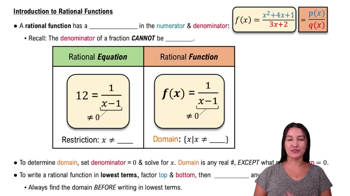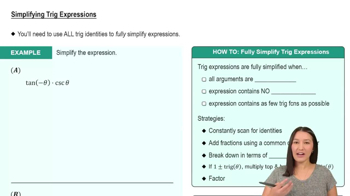Table of contents
- 0. Functions7h 52m
- Introduction to Functions16m
- Piecewise Functions10m
- Properties of Functions9m
- Common Functions1h 8m
- Transformations5m
- Combining Functions27m
- Exponent rules32m
- Exponential Functions28m
- Logarithmic Functions24m
- Properties of Logarithms34m
- Exponential & Logarithmic Equations35m
- Introduction to Trigonometric Functions38m
- Graphs of Trigonometric Functions44m
- Trigonometric Identities47m
- Inverse Trigonometric Functions48m
- 1. Limits and Continuity2h 2m
- 2. Intro to Derivatives1h 33m
- 3. Techniques of Differentiation3h 18m
- 4. Applications of Derivatives2h 38m
- 5. Graphical Applications of Derivatives6h 2m
- 6. Derivatives of Inverse, Exponential, & Logarithmic Functions2h 37m
- 7. Antiderivatives & Indefinite Integrals1h 26m
- 8. Definite Integrals4h 44m
- 9. Graphical Applications of Integrals2h 27m
- 10. Physics Applications of Integrals 2h 22m
1. Limits and Continuity
Finding Limits Algebraically
Problem 12b
Textbook Question
Finding Limits
In Exercises 9–24, find the limit or explain why it does not exist.
lim x→a (x² ― a²)/(x⁴ ― a⁴)
 Verified step by step guidance
Verified step by step guidance1
First, recognize that the expression (x² - a²)/(x⁴ - a⁴) is a rational function. To find the limit as x approaches a, we need to simplify the expression, especially since direct substitution would lead to an indeterminate form 0/0.
Notice that both the numerator and the denominator are differences of squares. The numerator x² - a² can be factored as (x - a)(x + a). Similarly, the denominator x⁴ - a⁴ can be factored using the difference of squares twice: first as (x² - a²)(x² + a²), and then further factor x² - a² as (x - a)(x + a).
After factoring, the expression becomes ((x - a)(x + a))/((x - a)(x + a)(x² + a²)). Cancel the common factors (x - a)(x + a) from the numerator and the denominator, provided x ≠ a.
The simplified expression is now 1/(x² + a²). This expression is no longer indeterminate as x approaches a.
Finally, evaluate the limit by substituting x = a into the simplified expression, which is now straightforward since it no longer results in an indeterminate form.
 Verified video answer for a similar problem:
Verified video answer for a similar problem:This video solution was recommended by our tutors as helpful for the problem above
Video duration:
3mPlay a video:
Was this helpful?
Key Concepts
Here are the essential concepts you must grasp in order to answer the question correctly.
Limits
A limit is a fundamental concept in calculus that describes the behavior of a function as its input approaches a certain value. It helps in understanding how functions behave near specific points, which is crucial for analyzing continuity, derivatives, and integrals. In this case, we are interested in the limit of a rational function as x approaches a.
Recommended video:

One-Sided Limits
Rational Functions
Rational functions are expressions formed by the ratio of two polynomials. They can exhibit unique behaviors, such as asymptotes and discontinuities, depending on the values of x. In the given limit problem, both the numerator and denominator are polynomials, and their degrees will influence the limit's existence and value as x approaches a.
Recommended video:

Intro to Rational Functions
Factoring and Simplifying
Factoring and simplifying expressions is a key technique in calculus for evaluating limits, especially when direct substitution leads to indeterminate forms like 0/0. By factoring the numerator and denominator, we can often cancel common terms, making it easier to find the limit as x approaches a. This process is essential for resolving the limit in the given exercise.
Recommended video:

Simplifying Trig Expressions

 5:21m
5:21mWatch next
Master Finding Limits by Direct Substitution with a bite sized video explanation from Callie
Start learningRelated Videos
Related Practice







